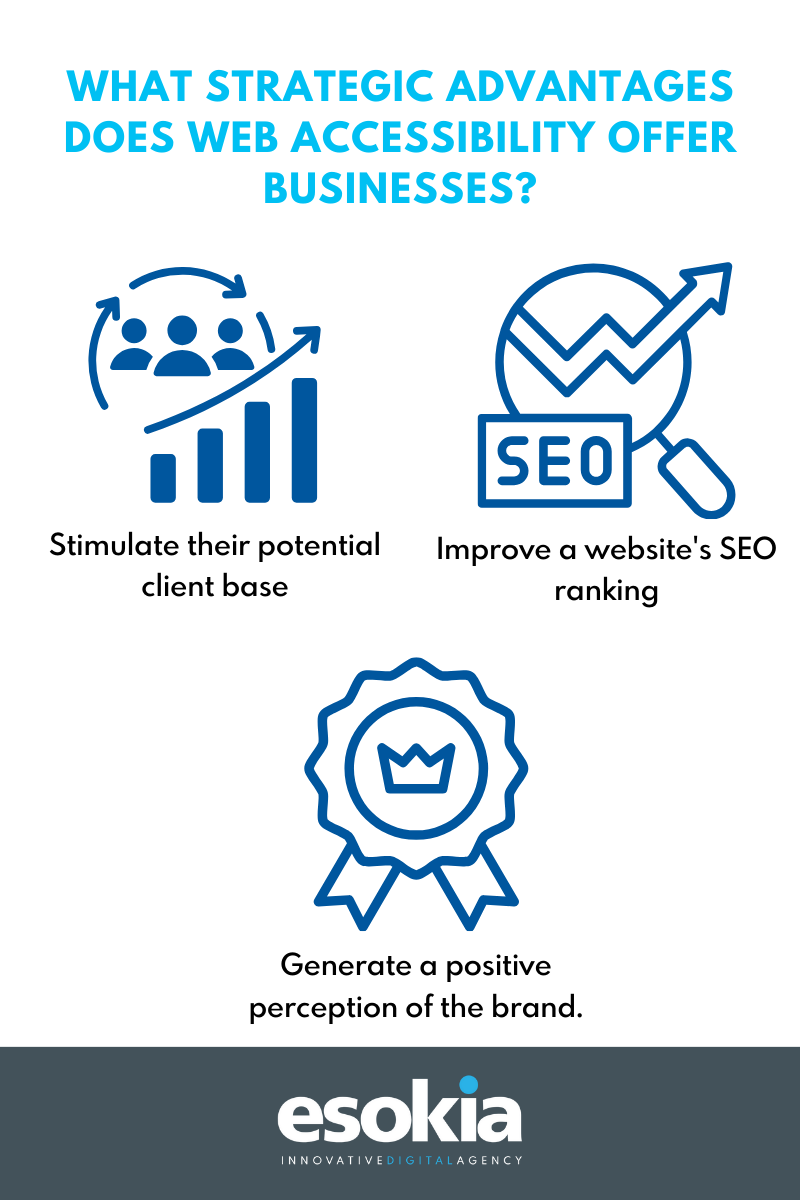What is web design accessibility?
Web design accessibility, or digital accessibility, refers to the design of websites that are easily accessible to all users, regardless of their physical or cognitive disabilities. It's a discipline that aims to eliminate barriers that might prevent disabled people from interacting with, or accessing, websites.
This concept is essential in interface design and web ergonomics, as it enables the creation of high-quality websites that do not exclude users from their products and services.
Web design accessibility is a practice that requires an understanding of the different ways in which people interact with web technology. This includes understanding the assistive technologies people can use to access the web, such as screen readers, special keyboards and speech recognition software. This is an essential skill in web design, and any serious web developer needs to take it into account.
Accessibility and usability: what's the difference?
Accessibility and usability are two key concepts in interface design and web ergonomics, but they are not identical. Accessibility refers to the ability of a website to be used by all people, regardless of their abilities. This includes disabled and elderly people who may have difficulty using a computer or navigating the web.
Usability, on the other hand, refers to the ease with which a user can understand and use a website. A website can be accessible without being user-friendly, and vice versa. A website might be accessible because it can be used with a screen reader, but it might not be user-friendly if its design is complicated and difficult to understand. Good UX design takes into account both accessibility and user-friendliness.
Why is it so important to have an accessible website?
Ensuring the accessibility of a website is of paramount importance from a number of professional points of view. Firstly, it's a question of respecting fundamental rights, where every individual must be able to access information and services online, regardless of their abilities. Secondly, in legal terms, many jurisdictions have established web accessibility standards that are binding on companies.
In addition, web accessibility offers significant strategic and commercial advantages. An accessible website can expand its audience and increase sales potential, helping to boost revenues and profits. It also enhances the company's reputation and brand image, while giving it a competitive edge in the marketplace. Finally, investing in web accessibility reflects a company's ethical values and social responsibility.
Who is affected by web design accessibility?
Web design accessibility is a universal concern, affecting various categories of people. This includes people with disabilities, who may encounter obstacles when using a computer or surfing the web. The elderly are also part of this population, as they are likely to encounter difficulties related to vision or dexterity, complicating the use of a computer.
Web design accessibility also concerns populations living in rural or developing areas, where access to the latest web technologies may be limited. In addition, it concerns users of assistive technologies, such as screen readers, special keyboards and voice recognition software, which are essential for their web browsing.
The different types of disability
Web design accessibility aims to ensure that people with different types of disability can access and use websites effectively. These disabilities can include :
Blindness
Individuals have limited or no vision and rely on assistive technologies such as screen readers to access content.
Deafness
This involves partial or total hearing loss, requiring attention to visual alternatives for communication, such as subtitles and sign language videos.
Motor disabilities
Motor disabilities include paralysis or mobility limitations that affect a person's ability to use a keyboard or mouse. To make websites accessible to people with motor disabilities, it is essential to design functionalities that are accessible via the keyboard, and to ensure intuitive, simplified navigation.
Cognitive disorders
Cognitive disorders include difficulties with learning, comprehension or concentration. To make websites accessible to people with cognitive impairments, it is important to present content clearly and concisely, with simplified navigation to facilitate comprehension and retention of information.
What strategic advantages does Web accessibility offer businesses?

By offering an accessible user experience, companies extend their reach to a more diverse audience, which can boost their potential customer base. What's more, better accessibility can improve a website' s SEO ranking, since search engines like Google value sites offering an optimal user experience.
By strengthening a company's brand image, it demonstrates its commitment to inclusion and equal access for all, which can improve customer loyalty and generate a positive brand perception. Ultimately, investing in web accessibility is not only socially responsible, but also commercially beneficial.
Which accessibility standards and legislation are essential?
Compliance with standards such as the WCAG (Web Content Accessibility Guidelines) of the W3C (World Wide Web Consortium) and legislation such as the ADA (Americans with Disabilities Act) in the USA is crucial to guaranteeing optimal web accessibility.
These guidelines provide an essential framework to follow to ensure that websites are accessible to all, regardless of ability or disability, and thus avoid the risk of litigation and loss of reputation for companies.
Who is concerned by the Declaration of Digital Accessibility?
Pursuant to Article 47 of the law, the Digital Accessibility Declaration applies to a variety of entities, including legal entities governed by public law, legal entities governed by private law entrusted with a public service mission, and companies with sales in excess of 250 million euros. However, it does not apply to audiovisual media service providers, nor to private non-profit organizations that do not provide essential services for the public or specifically meet the needs of disabled people.
Esokia: Committed to Optimizing Web Accessibility for Inclusive Browsing
Esokia is committed to optimizing web accessibility for inclusive browsing. We believe that everyone should have equal access to the information and services available on the web, and we work hard to make this possible.
We use a variety of techniques and technologies to make our websites accessible. This includes using HTML and CSS to create designs that can be used by people of all abilities.
Entrust us with your projects and together we'll make the web an accessible space for everyone.
- Log in to post comments
